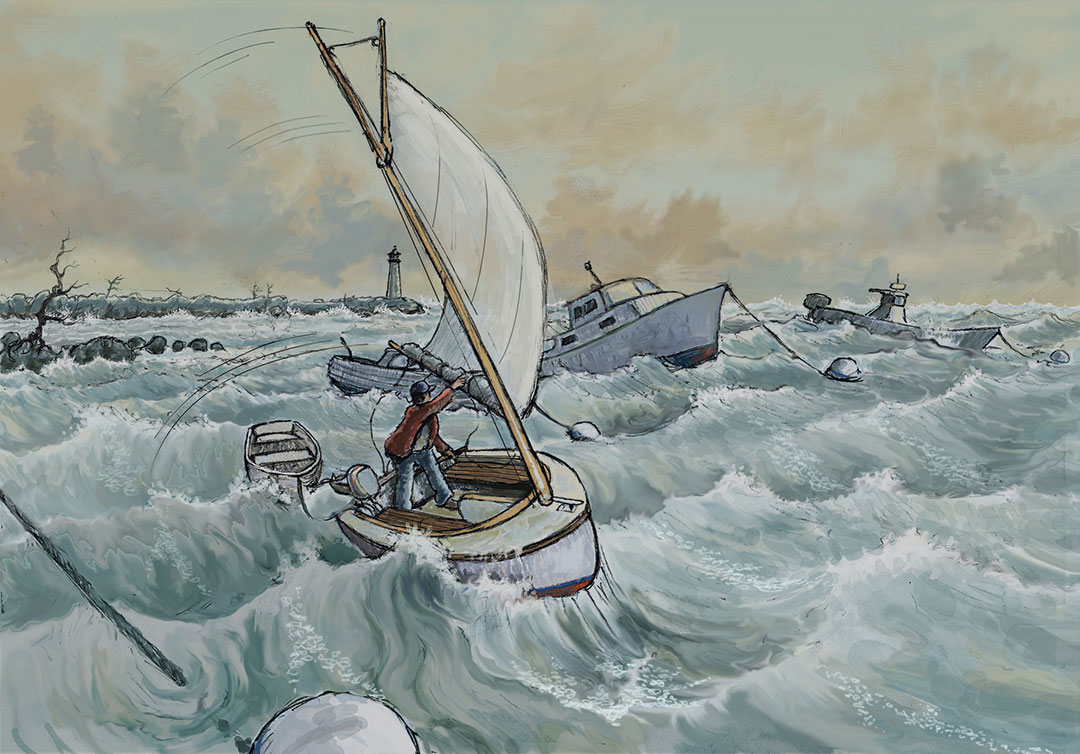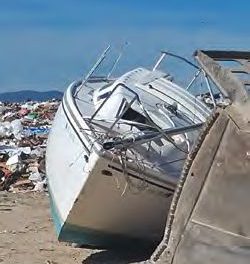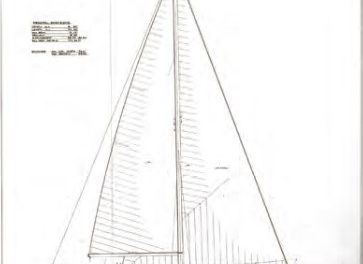Even a small boat can teach big lessons when it comes to abrupt, discontinuous change.
Issue 135: Nov/Dec 2020
Ellen and I have owned our 12-foot catboat, Finn, for 16 years. We love how the working catboats of yore live in her sweet lines. We love how she keeps us in touch with the water, literally; as we zoom along, we can reach over and trail our fingers in the waters of Buzzards Bay. Bruises and scrapes and sore muscles aside, during our years with Finn we’ve stayed mostly free—thank you, Neptune—of major mishaps. I wrote “mostly.” How could we not have experienced a true miscue or two (or three) over all those years? Well, we have.
Weathercock Weather
The time to haul out for the year had arrived, and with it 20-knot northeast gusts under skies the color of tin. But facing the prospect of a long New England winter ahead, not once setting foot aboard Finn, I opted to sail the quarter mile around the breakwater to the inner harbor and the landing. And I really didn’t have a choice; the motor had been kaput for years.
The first gust that hit us after we dropped off the mooring put us in irons. No problem. Towing the dinghy must be the reason, I thought, so I sailed to the beach and dropped her off.
In the next gust, Finn again rounded right up into it. What was happening? Better go back for the dinghy and use it to tow Finn.
The gusts had a different idea. Another heavy one hit us, and the boat swung into it and would not respond when I tried to ease off. Then we accelerated—backwards. I thrashed the tiller to turn us around, but we slipped over the scaling chop at an increasing speed—dead for the open bay.
I ran through our options. Sail with full canvas? Scandalize? (Non-catboat sailors may not know this term; see “Catspeak” below.) Hail a passing boat?
Not a single vessel appeared in any direction—not a surprise for a raw, sporty day in October. The wind increased, streaking the grim, gray waves with foam. I scanned the widening water, my sense of time dissolving—and my dread increasing. We’d soon drift beyond the rocks at the end of Nye’s Neck on a course for Cleveland Ledge Light several miles out into open water.
Under full sail, all I could manage to make Finn do was to round up into the wind, sail flogging, and lose headway. I scandalized the sail, but the boat still did not respond. Was the centerboard to blame? Now we drifted toward a mooring field where several powerboats seesawed, the chop slapping loudly on their hulls.
As we closed in on the boats, a word from the depths of my nautical knowledge surfaced. Weathercocking. In heavier weather, a catboat’s big sail can act like a weathervane and cause the boat to veer into the wind and stop her in her tracks. I remembered the term, but I didn’t know how to cope with its ramifications. Would we stay on this course and sidestep the powerboats?
A gust hit us and Finn rounded up. She sat quaking as if surrendering, her drift now shifted toward the mooring area. Beyond the boats, rocks boiled with breakers.
I had only one trick left. I dropped the sail and paddled stern-first to a rocky beach between two jetties. A wave soaked me when I waded in to set the anchor. Above the beach, an old man stood on a wooden landing, leaning his elbows on the rail as he watched me.

I stood shivering in the wave wash, my brain blurring. In the distance, a white-hulled ketch left the harbor that had been my destination. She set a course across the far side of the bay—too far to flag down. Then from out of the open water, I saw an inflatable boat approaching. It idled about 50 yards off the beach. A voice over a loudspeaker asked if I was OK.
Then I realized that I was experiencing my first encounter with Sea Tow. The boat had come for me. He told me to sail out to him, that he drew too much water to come in for me. Numb in body and mind, I climbed back aboard my yawing vessel, staggered aft with the rudder, and struggled to align pintle and gudgeon. The thought swam around in my near-
hypothermic mind that if I could sail out to him, then I could just as well sail home.
The old guy ashore yelled to the tow boat skipper to float a line to me instead. The tow boat skipper needed a few minutes to consider this option. At last he attached a tow line to a life vest and let it drift it toward me. But the gusts kept forcing it out, so I had to swim for it. When I finally tied it to my foredeck cleat, I tumbled into the cockpit, quaking. The tow boat took off and I spent a marrow-numbing five minutes re-crossing the water I’d spent five hours battling.
At the harbor, Ellen, looking shaken, met me in the parking lot. She said that she had no choice but to call Sea Tow or the Coast Guard. The ketch I’d seen? My wife had seen her skipper climbing into an inflatable and asked him for help. He told her that he had too much to do before shoving off on a cruise, so he didn’t have time to give me a tow.
An Unplanned Launch
A raw easterly puffing to 20 knots turned the waters of Buzzards Bay into writhing, slate-colored chop. In the thick of it, my brother-in-law, Tom, and I motored Finn from her mooring around the breakwater to Megansett Harbor. I’d wanted to mark the end of our first season of owning Finn with a last sail, but throwing the outboard on her seemed more prudent given the conditions. Even though it was a short jaunt from the outer harbor, we arrived at the launch ramp soaked by the cold spray.
We loaded Finn on the trailer and brought her into the public beach parking lot to down-rig her. Then gusts kicked up, grit lashed the boat, and spits of rain snapped against my cheeks. A chill cut me to the marrow, wet as I already was. Why not take her the quarter mile up the road to the house and finish decommissioning in the lee, out of the sandblasting gusts?
So, off we rolled, me at the helm of our old Nissan, the boat looking proud (and maybe relieved) on the trailer behind us. As we eased up County Road, I eyeballed the wires on the telephone poles: Finn’s masthead had ample clearance.
The road rose up a slight incline and I glanced in the rearview mirror as we topped the knoll. Wait! Why was Finn receding from view?
Then her bow reared up and the boat disappeared. What sounded like a colossal kettle-drum thundered twice through my open window. I jammed on the brakes and flew out the door. A few feet behind the trailer, Finn sat atilt on the hard as if a hurricane had dropped her there.
Tom and I never would have been able to lift her back onto the trailer without the help of four workmen who had been shingling a nearby cottage. They hustled over as we assessed the situation. I spotted the reason I knocked my boat off the trailer: In this one spot, the rise had lifted Finn high enough that her mast met a wire looping low from a telephone pole; it held Finn fast while I drove the trailer out from under her.
I cringed. Were those smirks I saw on their faces when I told them what I’d done? We counted one, two, three, hefted her up, and slid her back aboard the trailer. We inched down the remaining 100-foot slope to the house, where I inspected the damage: for Finn, a slight crack in her skeg, for my pride, a permanent dent.

A Turn for the Worse
I tied in a reef and took one last look around before dropping off the mooring: temperature in the mid-70s, rich blue sky, wampum-colored clumps of cloud moving along the northern horizon, air clean and dry, visibility vivid and unlimited. The only hitch was that the wind gusted to 15, 16, 18 knots out of the north. These gusts would set me into the nearby rocks the moment I left the mooring. I had a brainstorm: cleat the mainsheet so I could get underway faster and skirt the rocks. I waited for a lull, cleated off, and jumped onto the foredeck.
Before I could release us from the mooring, a gust hit. Finn rounded into the wind. She heeled over hard, sailing forward, the mooring line lassoing her. I jumped to shift my weight to windward but because the sheet was cleated the sail stayed stiff, taking the full force of the wind. In seconds, over went boat and skipper.
When I surfaced, disbelief swept over me. What had I done? Mast and sail lay flat in the water, cockpit half submerged, centerboard exposed.
I realized what I had to do—and it wasn’t to flog myself for making a greenhorn’s mistake even though I’d been sailing for almost 60 years, 10 of them aboard Finn. I swam around to the centerboard and set my feet on it. Then I latched onto the rail to pull backwards; maybe the counterbalance of my weight would lift the boat. But Finn’s cockpit is as big as a jumbo hot tub, and now it was awash. The water in the cockpit had become a small aquarium, alive with translucent bell-shaped Ctenophora, or comb jellies, organisms that don’t sting but glow with bioluminescence at night.
I swam back around to the sail and fumbled to release the sheet, then tugged the sail through the water to pull it down the mast. I lashed the sail and swam around to try to right her again. No go. I had to try to bail her out, but the water—clear and relatively warm for New England—was washing over the coaming and pouring in through the centerboard trunk. She was nearly sunk.
This time when I leaned my whole weight on the starboard side, I raised the coaming far enough out of the water so no more water sloshed in. I was heaving back on the rail again when a fellow catboater swam out and grabbed two bailers off Petrel, moored next to us. With the two of us bailing, we managed to stem the flow. From beneath the foredeck, I liberated my hand pump and finished off the job. At last, Finn was atop the water, bobbing like a gull.
The Takeaway
Over the years, I’ve mused about these Finn follies and concluded that all could have been avoided if I had heeded the sailor’s creed (at least this sailor’s creed): Beware the bonehead. That really translates to mean: Never hesitate to question your own assumptions (and sometimes those of others).
I could have avoided knocking the boat off the trailer if I had taken the time to inspect the route and not rushed to get out of the elements. I assumed that all the wires along the road to the house ran at the same height they did down at the harbor. My haste did bring me a touch of luck, however: Instead of securing her to the trailer winch, I left her untethered, figuring she’d never budge on the short ride to the house. That assumption turned out to be wrong, too, but if I had secured her, I probably would have broken her mast when it hit the wire.
Bottom line, however, is never to trailer a boat with the mast up when there are overhead wires anywhere along the route. In this case, all I did was flip the boat off my trailer. In the worst case, I could have been electrocuted had I hit a hot wire.
Flipping Finn still figures in my nightmares. Before I capsized her, I had her pegged as almost unflippable because of her 6-foot beam. I proved that theory wrong, too, and have found over the first seven or so years of sailing her that she’s much more tender than I’d thought. But capsizing was not Finn’s fault. Ignore the basics at your peril, and my cleating the sheet in those gusts almost guaranteed that some disaster would befall us. I would have negotiated the nearby rocks had I allowed the sail to luff till we drifted downwind of them and then sheeted in. Not to mention, if I had heeded the old sailor’s superstition, I would have stayed ashore: Never start a voyage on a Friday. This one also happened to be the 13th.
Finding myself adrift proved that I could remain calm even in an unfolding disaster, and that I could draw on my experience to attempt to right the situation. But the ordeal started with an error: I listened only to my heart, not my head, by succumbing to my need to sail one last time before the end of the season and ignoring the hazards before me. The mistakes I made—sailing in conditions too rough for my boat, not having any means of communication aboard (during a New England fall no less), not questioning the tow boat skipper’s order to sail out to him, not anchoring instead of allowing the boat to drift miles across the bay—could have had even more serious repercussions than skinned knees, chills, and a trophy bill.
Craig Moodie lives with his wife, Ellen, in Massachusetts. His work includes A Sailor’s Valentine and Other Stories and, under the name John Macfarlane, the middle-grade novel Stormstruck!, a Kirkus Best Book.
Thank you to Sailrite Enterprises, Inc., for providing free access to back issues of Good Old Boat through intellectual property rights. Sailrite.com






